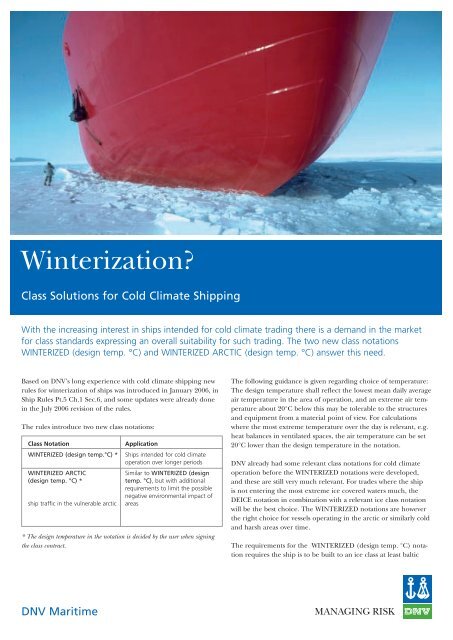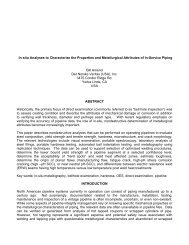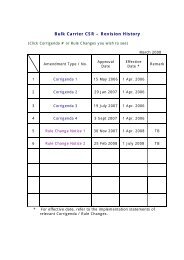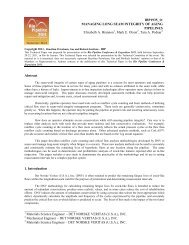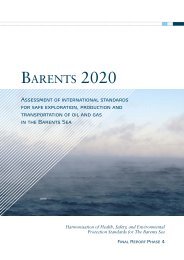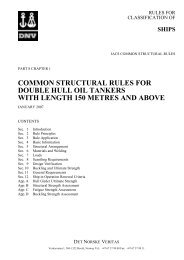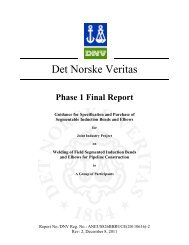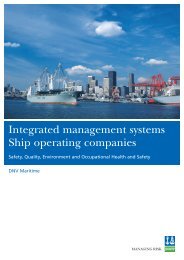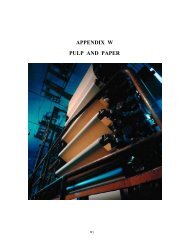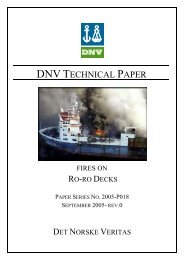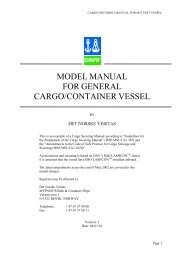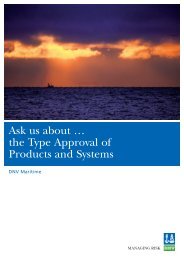Flyer Winterzation.qxd - DnV
Flyer Winterzation.qxd - DnV
Flyer Winterzation.qxd - DnV
- No tags were found...
You also want an ePaper? Increase the reach of your titles
YUMPU automatically turns print PDFs into web optimized ePapers that Google loves.
Winterization?Class Solutions for Cold Climate ShippingWith the increasing interest in ships intended for cold climate trading there is a demand in the marketfor class standards expressing an overall suitability for such trading. The two new class notationsWINTERIZED (design temp. °C) and WINTERIZED ARCTIC (design temp. °C) answer this need.Based on DNV’s long experience with cold climate shipping newrules for winterization of ships was introduced in January 2006, inShip Rules Pt.5 Ch.1 Sec.6, and some updates were already donein the July 2006 revision of the rules.The rules introduce two new class notations:Class NotationWINTERIZED (design temp.°C) *WINTERIZED ARCTIC(design temp. °C) *ship traffic in the vulnerable arcticApplicationShips intended for cold climateoperation over longer periodsSimilar to WINTERIZED (designtemp. °C), but with additionalrequirements to limit the possiblenegative environmental impact ofareas* The design temperature in the notation is decided by the user when signingthe class contract.The following guidance is given regarding choice of temperature:The design temperature shall reflect the lowest mean daily averageair temperature in the area of operation, and an extreme air temperatureabout 20°C below this may be tolerable to the structuresand equipment from a material point of view. For calculationswhere the most extreme temperature over the day is relevant, e.g.heat balances in ventilated spaces, the air temperature can be set20°C lower than the design temperature in the notation.DNV already had some relevant class notations for cold climateoperation before the WINTERIZED notations were developed,and these are still very much relevant. For trades where the shipis not entering the most extreme ice covered waters much, theDEICE notation in combination with a relevant ice class notationwill be the best choice. The WINTERIZED notations are howeverthe right choice for vessels operating in the arctic or similarly coldand harsh areas over time.The requirements for the WINTERIZED (design temp. °C) notationrequires the ship is to be built to an ice class at least balticDNV Maritime
Winterization – Class Solutions for Cold Climate ShippingAdditional safety equipment for extreme weather is also added inthe winterization rules, e.g. thermal protection suits are to be providedfor all crew members, an ice search light is required fittedon the wheelhouse top, and immersion suits are to be of the insulatedtype.ICE-1C, which leads to some minimum requirements for hulland machinery arrangement, but still opens for considerationson which ice class will be the correct one depending on the actualanticipated trade.The requirements of the DEICE notation are to be followed, withadditions. The additions are needed because the DEICE notationis concerned only with the safety of the vessel and the crew duringship icing, while the winterization notation also includes normaloperation, and in more harsh environments. The DEICE rulesbasically states that safety important equipment must be kept freefrom ice without stating the specific solution to be chosen. Thewinterization rules on the other hand require much equipmentto be located inside deck houses, for instance the anchor winchand life boats. In addition to what is covered by the DEICE notationanti-/deicing is also required for mooring equipment, anchorchain and cargo handling equipment.Heating is required for some more systems like the fire extinguishingsystem, hydraulic systems in cold spaces, and heating is requiredin engine rooms and other spaces containing important equipmentunless the equipment and piping installations can operate at thelowest temperature generated by the outdoor temperature, withrealistic space ventilation. For design temperatures below -10°Cheating in ballast tanks above sea water line and of fuel oil systemswill also be required, and the required heating capacity in deckareas/gangways for anti/deicing shall not be less than 450 W/m2 ,e.g. higher that the minimum given for DEICE.Another important part of the WINTERIZED requirements is thematerial requirements. Low temperature grade materials suitablefor the design temperature specified, are required used in:■ outer hull above ballast water line including deck houses andmasts (requirements for DAT notation to be fulfilled)■ equipment important for ship operations on deck or in nonheateddeckhouses; such as windlass, chain and chain stopper,mooring winches, cargo pipingIn addition to the technical requirements outlined for the WIN-TERIZED (design temp. °C) additional requirements are relevantfor the WINTERIZED ARCTIC (design temp. °C). The ship is tobe built to an ice class at least ICE-05 with additional requirementsfor CP-propeller for diesel driven propellers, or alternatively electricdriven propellers. Propeller material shall normally be stainlesssteel due to superior strength and ductility.Additional requirements for pollution prevention are included inthe WINTERIZED ARCTIC requirements since pollution is notacceptable for environmentally vulnerable arctic areas. Oil tankersare to be so arranged that the oil release after an incident is limited,this is covered by a requirement for maximum oil outflowindex. The class notations OPP-F and CLEAN are to be compliedwith, giving requirements for location of fuel bunker tanks awayfrom the ship side and other pollution prevention requirements.Non- toxic and biodegradable oil is required for stern tube andCPP systems, since these systems leak oil on a daily basis.Redundant propulsion is required for more reliable propulsionpower operating in remote and vulnerable waters. With the RPSnotation two engine rooms are provided, in this way with oneengine room out of action due to fire or flooding, the ship may beable to return to civilization under its own power, or at least to staysafe and warm where it is, until rescued. A ship operating in arcticareas can experience being stuck in ice for long periods, thereforeextra bunker capacity is also required.Relationship to other class notationsThe WINTERIZED (design temp. °C) notation include the requirements of the DEICE and DAT(-x °C) notations with additional requirementsintended to complete the picture. The ARCTIC notation also encompass the requirements of the environmental notations OPP-Fand CLEAN, with additional requirements. A minimum ice class notation is mandatory for both notations, and for the WINTERIZEDARCTIC (design temp. °C) notation also the RPS notation is made mandatory. Examples of class notation strings for winterized oil tankers:+1A1 TANKER FOR OIL ESP E0 WINTERIZED (-40°C) ICE-1C+1A1 TANKER FOR OIL ESP E0 WINTERIZED ARCTIC (-40°C) ICE-10 RPSFor additional information about the class notation section MTPNO880 can be contacted: mtpno880@dnv.com .300/ 9-2006 Coor Graphic Services 0609-069


